Patterns of World Trade | Geography Optional for UPSC PDF Download
Introduction
Trade refers to the exchange of goods and services between countries, with imports being the goods brought into a country and exports being the goods sold to other countries. Developed countries tend to have a larger share of global trade compared to developing countries. This is because developed countries usually export high-value manufactured products such as electronics and cars, while importing cheaper primary products like tea and coffee. Trading blocs, like the European Union, have a significant influence on world exports.
- From the 1950s to the 1980s, the majority of global trade took place between high-income countries like Germany, Japan, the United Kingdom, and the United States, as they contributed to most of the world's GDP, and developing countries maintained high trade barriers. The trade between these high-income countries is often referred to as North-North trade.
- However, the trends in global trade have been changing, with trade between developing countries (South-South trade) and between developed and developing countries (North-South trade) surpassing North-North trade. In 1985, high-income economies made up 80% of the world trade, but they are expected to account for less than 50% by the middle of the current decade.
- Although developed countries continue to dominate the export market, there is evidence that their share is gradually decreasing. This shift highlights the growing importance of trade between developing countries and between developed and developing countries in the global economy.
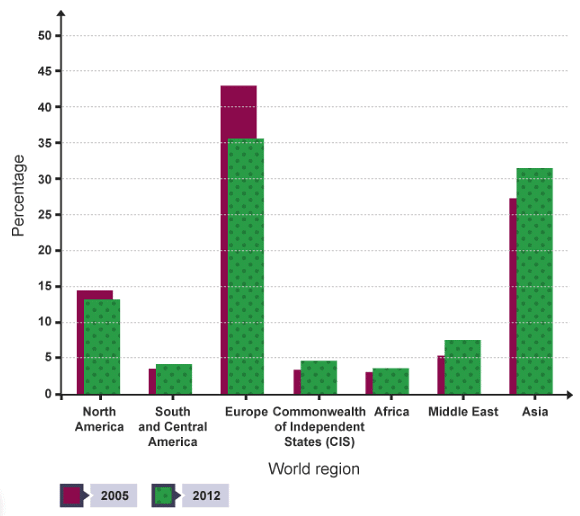
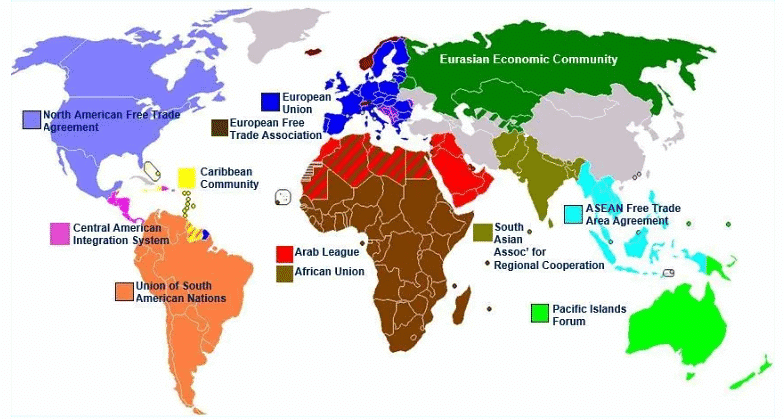 Trade Blocks
Trade Blocks
Over the past few decades, significant changes have occurred in the global trade landscape. Trade now accounts for nearly three times the global output compared to the early 1950s, largely due to the rapid growth and integration of emerging market economies (EMEs). The increase in trade is primarily attributed to the growth in non-commodity exports, particularly high-technology products such as computers and electronics.
Three key trends characterize these developments in global trade:
- The emergence of EMEs as crucial trading partners.
- The increasing importance of global supply chains.
- The continuous shift of technology content towards dynamic EMEs.
These trends have led to greater trade interconnectedness and have significant implications for trade patterns, especially in response to changes in relative prices. A major factor contributing to this is the expanding role of global supply chains in overall trade, which is enabled by lower tariffs and technology-driven reductions in transportation and communication costs.
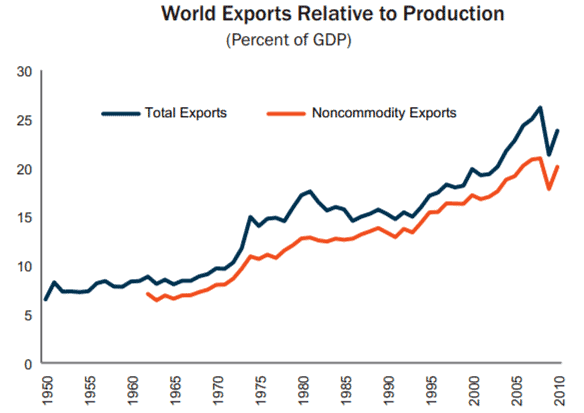
Emerging Economies and Trade
- Following the financial crisis, there has been a significant economic disparity between high-income and emerging economies. While the US, EU, and Japan have been slow to recover, emerging economies like China have been driving global recovery. The growth of lower and middle-income countries has been happening for about two decades. China's economic transition accelerated in the 1990s, and India's growth surged after its 1991 reforms.
- From 1992 to 2008, there was a significant increase in global exports. During this period, China saw an average annual growth rate in exports of 18%, while India's growth rate was 14%. Additionally, 15 other countries, including Brazil, Korea, Mexico, Russia, and others, experienced an annual growth rate in exports of 8%. As a result, the share of global exports from low and middle-income countries increased from 21% to 43%.
- The growth in South-South trade can be attributed to urbanization and industrialization in China and India, which has created demand for raw materials. Furthermore, the expansion of global production networks has led to an increase in trade for parts and components. Meanwhile, the growth in North-South trade has renewed interest in traditional theories of international trade.
Exports and Imports Relative to GDP by Regional Trading Partner
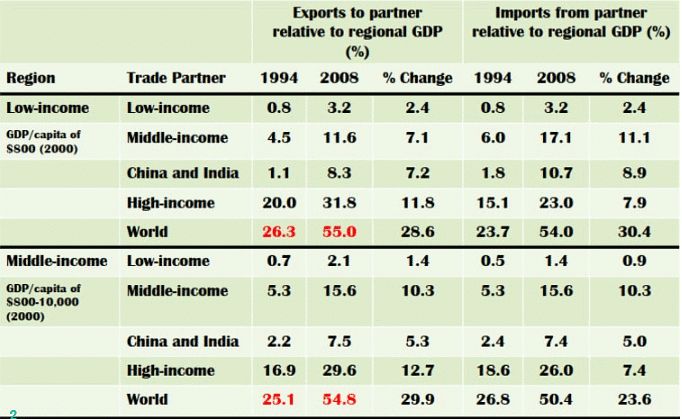
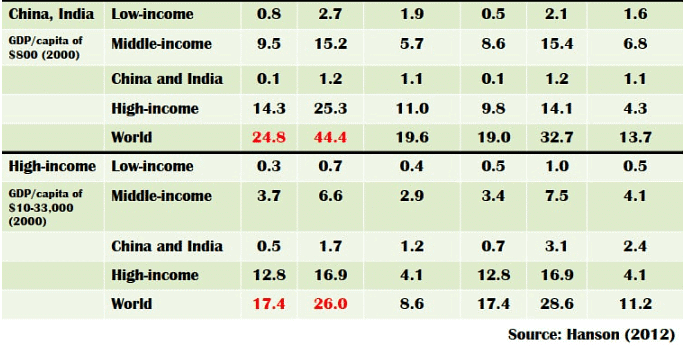
Changing Patterns of World Trade (1990s – 2008)
- For low and middle-income countries, exports as share of regional GDP has grown sharply, e.g., 26 to 55% (low-income), 25 to 55% (middle-income), and 25 to 55% (China and India) – similarly for imports.
- Lower trade growth for high-income countries, e.g., 17 to 26% in case of exports
- Change in trade pattern involves much larger South-South trade flows over period 1994-2008:
(i) share of exports from low to low and middle-income countries rose from 24 to 42%
(ii) share of exports from middle-income to low and middle-income countries rose from 33 to 46%
South-South Trade
- The primary reason for the growth in South-South trade is the expansion of multistage global production networks. This means that companies are now offshoring their production processes, allowing them to split up manufacturing across different countries to take advantage of the lowest costs in each location. As a result, the total exports (gross trade flows) might appear to be larger than the actual net trade flows (exports minus intermediates), leading some to believe that the growth in South-South trade is merely a statistical artifact.
- However, while double-counting may be a factor, there is evidence to suggest that emerging economies are indeed increasing their specialization in global markets. This indicates that the growth in South-South trade is not just a statistical illusion but is also driven by the increased specialization and integration of these economies into the global production network.
North-South Trade
- During the 1980s and 1990s, traditional trade models, such as the Ricardian and Heckscher-Ohlin models, lost their appeal due to the dominance of high-income countries in global trade. These models could not adequately explain the observed intra-industry trade among high-income countries, where similar products were traded between similar countries. For example, France would export cars while importing German cars.
- However, this trend shifted in the past decade due to the growth of countries like China and India, which indicated that differences in technology and resources play a significant role in motivating trade. As a result, international specialization began to align with comparative advantage patterns.
- Low-income countries typically have positive net exports in resource or labor-intensive sectors, such as agriculture, raw materials, and apparel and footwear. China and India, on the other hand, have positive net exports in labor-intensive sectors like apparel, footwear, electronics, and other types of manufacturing. Middle-income countries generally have negative net exports in capital-intensive sectors such as chemicals, machinery, and transportation equipment. Finally, high-income countries tend to have positive net exports in capital-intensive sectors like chemicals, machinery, and transportation equipment.
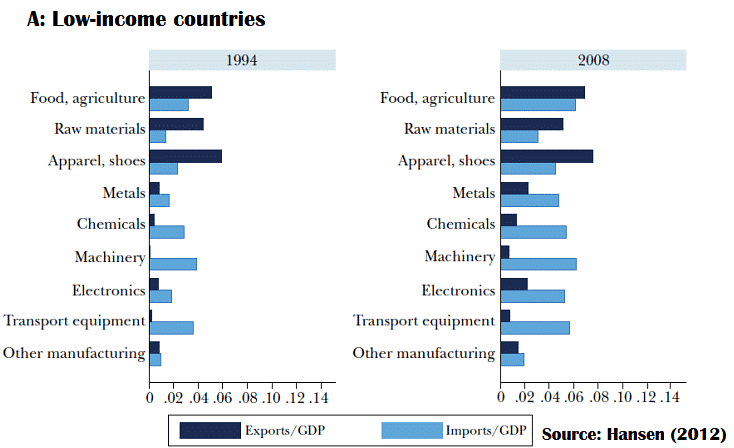
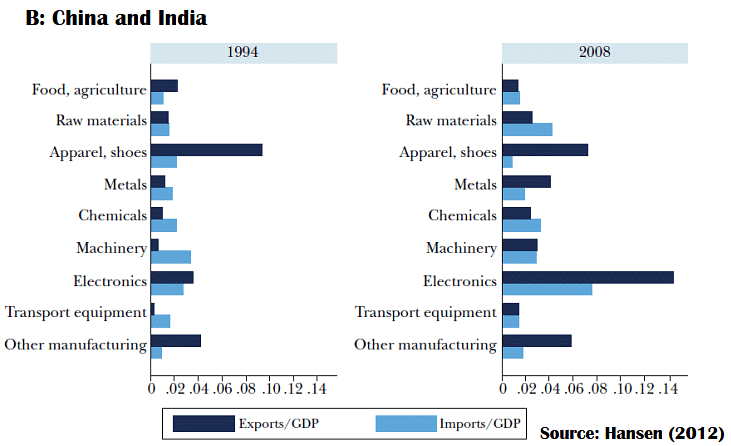
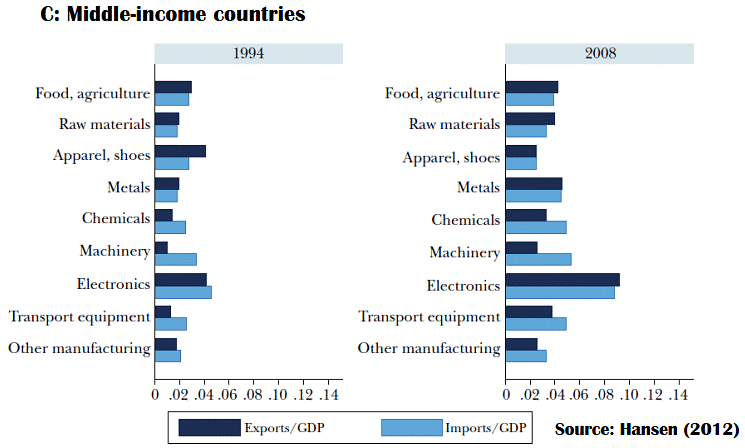
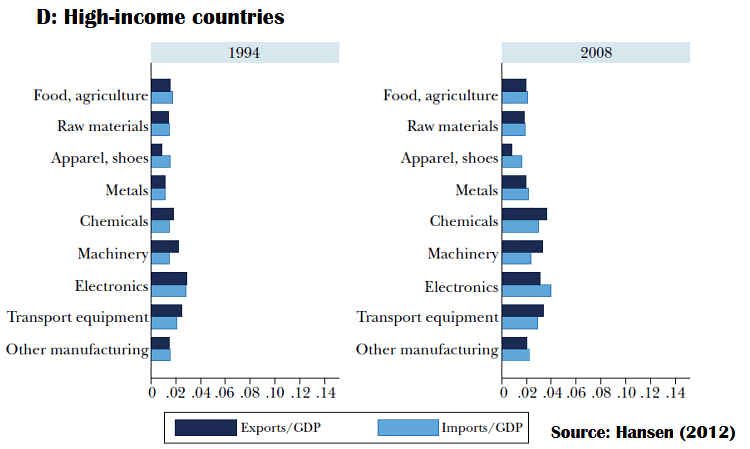
- South-South trade, which involves resource-poor emerging economies importing from resource-rich emerging economies, has been growing along the lines of comparative advantage. For low-income countries, 70% of agricultural export growth and 73% of raw materials growth can be attributed to shipments to low- and middle-income countries. These low-income countries mainly export clothing and footwear to high-income countries.
- Middle-income countries, on the other hand, have a diverse range of exports. These include agricultural products from Argentina and Brazil; metals from Russia, Korea, South Africa, and Chile; electronics from Korea, Malaysia, Thailand, and the Philippines; and transportation equipment from Korea, Mexico, Poland, and Turkey. 50% of the export growth in middle-income countries is directed towards other low- and middle-income countries, with the exception of automobiles. China and India alone account for more than 25% of exports of raw materials and electronics from middle-income countries, signifying their demand for minerals such as iron ore and copper, as well as their deepening involvement in production networks.
- Interestingly, China and India stand out among low- and middle-income countries for their dependence on high-income markets to absorb their exports. High-income countries have taken in more than 70% of China's export growth in apparel, footwear, and other manufactured items, and over 55% in electronics (for China) and metals (for India).
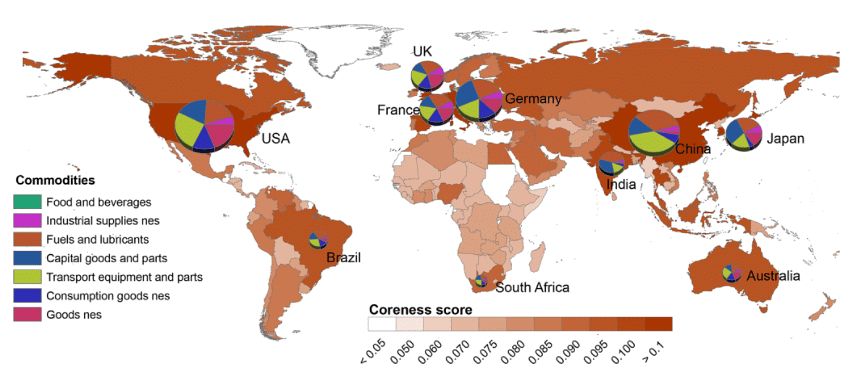
Dynamics in Specialization
- In summary, middle-income countries have shifted their specialization from labor-intensive industries such as apparel and footwear in 1994 to more capital-intensive sectors like electronics by 2008. This shift is in line with these countries accumulating human and physical capital. Meanwhile, low-income countries like Bangladesh and Vietnam are taking over the apparel and footwear industries that middle-income countries are leaving behind.
- China, as one of the middle-income countries, has not only switched from assembling labor-intensive products to more technologically advanced goods but has also significantly increased its value-added exports, such as mobile phones and laptops.
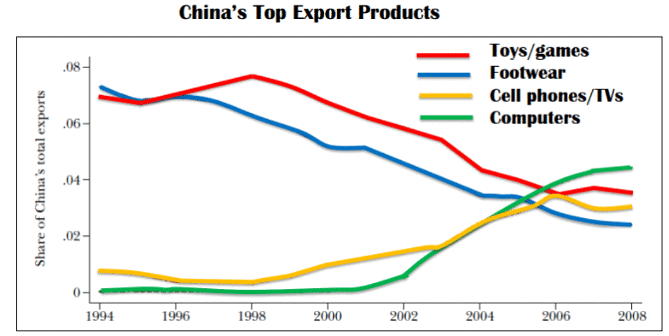
- Although some argue that China's export strength in electronics is due to industrial policy, others believe that the country's increasing supply of educated labor, investment from multinational firms, and improvements in infrastructure have contributed to its comparative advantage in the electronics sector.
Conclusion
In conclusion, the global trade landscape has shifted significantly in recent decades, with South-South trade and North-South trade surpassing North-North trade. Emerging economies like China and India have driven this change, with their rapid growth and integration into global production networks. As middle-income countries shift towards more capital-intensive sectors, low-income countries are taking over labor-intensive industries. This changing trade pattern highlights the growing importance of trade between developing countries and between developed and developing countries in the global economy.Frequently Asked Questions (FAQs) of Patterns of World Trade
What is the difference between North-North, South-South, and North-South trade?
North-North trade refers to trade between high-income or developed countries, while South-South trade occurs between developing countries. North-South trade involves the exchange of goods and services between developed and developing countries.
How has the growth of emerging market economies (EMEs) impacted global trade?
The rapid growth and integration of EMEs have led to an increase in trade, particularly in non-commodity exports like high-technology products. This growth has resulted in greater trade interconnectedness, the expansion of global supply chains, and a shift in technology content towards dynamic EMEs.
What factors have contributed to the growth of South-South trade?
The primary reason for the growth in South-South trade is the expansion of multistage global production networks, which allow companies to offshore their production processes and split manufacturing across different countries. This has led to increased specialization and integration of emerging economies into the global production network.
How have traditional trade models, such as the Ricardian and Heckscher-Ohlin models, regained relevance in recent years?
The growth of countries like China and India has highlighted the role of differences in technology and resources in motivating trade, leading to international specialization aligning with comparative advantage patterns. This development has renewed interest in traditional trade models that focus on these differences.
How has the specialization of low- and middle-income countries evolved in recent years?
Middle-income countries have shifted their specialization from labor-intensive industries such as apparel and footwear to more capital-intensive sectors like electronics. Low-income countries, on the other hand, have taken over the apparel and footwear industries that middle-income countries are leaving behind.
|
303 videos|636 docs|252 tests
|
FAQs on Patterns of World Trade - Geography Optional for UPSC
| 1. What are patterns of world trade? |  |
| 2. What are some common patterns of world trade? |  |
| 3. How does globalization affect patterns of world trade? |  |
| 4. What role do tariffs and trade barriers play in shaping patterns of world trade? |  |
| 5. How do technological advancements impact patterns of world trade? |  |





















